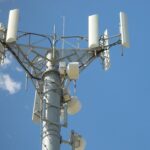Spectrum is for telecommunication what jet fuel is for aviation. Spectrum is a range of electromagnetic frequencies or airwaves that telecom companies use for establishing a connection between a cell tower and a mobile phone. The bandwidth of this spectrum is directly proportional to the speed of a wireless data network (since more data can be transmitted simultaneously through a broader data pipeline). In contrast, the frequency is inversely proportional to the coverage (since lower frequencies penetrate better through physical barriers and thus have wider coverage).
The spectrum holding data sheet embedded in this article represents the current spectrum holdings of all active telecom operators across all frequency bands across all 22 telecom circles along with their liberalisation status and expiry dates. All figures represented are in MHz. The value mentioned in the bracket beside the frequency at the base of each sheet is the band number where ‘B’ stands for 4G LTE band whereas ‘n’ stands for the corresponding 5G NR band.
The spectrum shown under BSNL and Aircel in white is reserved for the respective operators but has not yet been officially allotted to them.
Spectrum Liberalisation:
Spectrum was administratively allocated to operators in each of the 22 licensed service areas or circles prior to 2010, this spectrum is called non-liberalised and can only be used for 2G services whereas all airwaves allotted post-2010 have been through a Spectrum Auction where operators have paid the market discovered price and this spectrum is called liberalised and can be used for any technology platform 2G/3G/4G/5G. Alternatively, operators may choose to liberalise their administratively allotted spectrum by paying the market-discovered price to DoT on a pro-rata basis for the remaining validity of the spectrum.
Paired and Unpaired spectrum:
Spectrum may be paired or unpaired, bands 1/3/5/8/28 are all paired where one set of frequencies is used for uplink whereas another distinct set of frequencies is used for downlink known as Frequency-division duplexing (FDD), whereas bands 40/41/78/258 are unpaired where both uplink and downlink happens in the same set of frequencies separated by the time of uplink and downlink known as Time-division duplexing (TDD).
List of Indian FDD Bands:
| 4G LTE band | 5G NR band | Uplink frequency range (MHz) | Downlink frequency range (MHz) | Bandwidth for telecom (MHz) | Block size (MHz) |
|---|---|---|---|---|---|
| B1 | n1 | 1939-1979 | 2129-2169 | 40×2 | 5×2 |
| B3 | n3 | 1710-1780 | 1805-1875 | 70×2 | 0.2×2 |
| B5 | n5 | 824-844 | 869-889 | 20×2 | 1.25×2 |
| B8 | n8 | 890-915 | 935-960 | 25×2 | 0.2×2 |
| B28 | n28 | 723-733/ 738-748 | 778-788/ 793-803 | 20×2 | 5×2 |
List of Indian TDD Bands:
| 4G LTE band | 5G NR band | Frequency range (MHz) | Bandwidth for telecom (MHz) | Block size (MHz) |
|---|---|---|---|---|
| B40 | n40 | 2300-2380 | 80 | 10 |
| B41 | n41 | 2535-2555/ 2635-2655 | 40 | 10 |
| – | n78 | 3300-3670 | 370 | 10 |
| – | n258 | 24250-27500 | 3250 | 50 |
Spectrum caps:
A spectrum cap dictates how much spectrum a particular operator can hold in a circle for a specific band. There is a 40% cap for Sub-GHz spectrum in the 700/850/900 MHz bands combined, a 40% cap for Mid-Band spectrum in the 1800/2100/2300/2500 MHz bands combined, a 40% cap for the C-Band spectrum of 3300-3670 MHz and a 40% cap for the mm-Wave spectrum bands of 24.25-27.5 GHz. The current spectrum caps are denoted in the spectrum chart.
Overall spectrum holdings of operators (in MHz):
| Operator/Holding | Jio | Airtel | Vi | BSNL |
|---|---|---|---|---|
| Sub-GHz | 890 | 373.2 | 298.8 | 496 |
| Mid Band | 1470.8 | 1964.9 | 1531.6 | 590 |
| C-Band | 2440 | 2200 | 850 | 0 |
| mm-Wave Band | 22000 | 17600 | 5350 | 0 |
| Total | 26,800.8 | 22,138.1 | 8,030.4 | 1,086 |
Spectrum sharing/trading/leasing guidelines:
- Telecom operators holding CMTS/UASL/UL licenses can enter into a Spectrum-Sharing agreement with each other so long as both parties hold liberalised spectrum in the same band in the same circle. Sharing of spectrum is possible only on a Pan LSA level in block sizes defined by DoT and only after one year of the spectrum being acquired by an operator.
- Telecom operators holding CMTS/UASL/UL licenses can enter into a Spectrum-Trading agreement with each other so long as the spectrum being sold is liberalised. Trading of spectrum is possible only on a Pan LSA level in block sizes defined by DoT and only after two years of the spectrum being acquired by an operator.
- Telecom operators may enter into a Spectrum-Leasing agreement only with Enterprises holding a Captive Non-Public Network (CNPN) license and not with each other. The lease may be limited to any geographic area within the LSA and for any duration mutually agreed upon by both parties. A CNPN licensee can lease spectrum from multiple operators within an LSA.
Note: We update this chart in real-time to ensure it is always up to date with the latest changes in spectrum holding. Certain human errors might have crept in during the manual compilation of the data, any mistakes/ rectification can be brought to the Team’s notice through the comments section below.








@esmail What is your view for n71 600mhz ?
Not n71 that’s the band plan for America, whereas for India we will implement 600 MHz as n105 as per Asia Pacific telecommunity. Just like 700 MHz in India is implemented as n28 not as n12/13/14 in America.
Also the device ecosystem in 600 MHz hasn’t developed which is why the demand from telcos is low, and it wasn’t put up for auction this time.
Ideally DoT should move Railway and Defence allotment to this band and free up n28 for the telecom sector, since the Railway and Defence communication infrastructure will be built from scratch and can be indigenously customised by TCS and Jio using their in house stack while the commercial 5G deployments can be accelerated in the well established n28 with good device market penetration.
DOT has not release 40 mhz in sub ghz band, 199 mhz in mid band and 130 mhz in c band plus defence and railway reserve.
DOT should not introduce any new band and released completely spectrum in current band.
In bihar circle, band 41 has 0 MHz left unsold
Thanks for pointing out the error, it has been rectified. I had forgotten to remove it from unsold after adding it to Vi holding.
Hey @esmail otherthan indus tower and American tower cooperation is there any other company for tower sharing.
Indus is the only major provider (2nd largest in India) with shared tenancy catering to Airtel and Vi. Apart from them you have smaller players like Tower vision, GTL infrastructure, HFCL Ltd. With insignificant market share.
As for American tower corp it was acquired by Brookfield Infrastructure (now the largest tower company in India) earlier this year who had also bought bought Reliance Jio Infratel 4 years back has a single tenancy agreement with Jio for 30 years.
BSNL has its own tower portfolio which is used by it and MTNL.
So 30 year single tendency agreement will be applicable for ATC Infra which is acquired by Brookfield or not?
I don’t know the exact contours of the deal. The ATC towers may or may not be a part of the exclusive deal between Jio and Brookfield but the dues owed by Vi for it’s usage prior to the acquisition by Brookfield will be receivable by ATC parent company only, that was clarified in the acquisition deal.